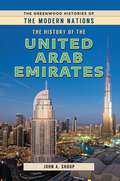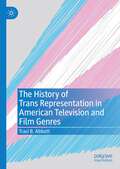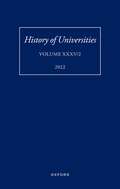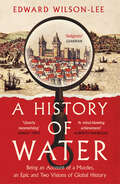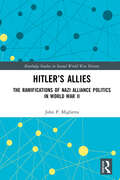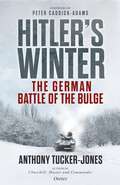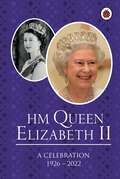- Table View
- List View
The History of the United Arab Emirates (The Greenwood Histories of the Modern Nations)
by John A. ShoupThis volume explores the political, cultural, and economic history of the United Arab Emirates, from early antiquity to the present.The United Arab Emirates is a relatively young country in the Middle East, made up of seven emirates: Abu Dhabi, Ajman, Dubai, Fujairah, Ras Al Khaimah, Sharjah, and Umm Al Quwain. How did these seven separate emirates come together to form the United Arab Emirates?This volume explores the long, rich history of these seven emirates, focusing on political history but also highlighting culture, society, economy, and religion. Chronologically arranged chapters examine major eras and turning points in history, such as antiquity, the rise of Islam, British trade, and the discovery of black gold: oil. Readers will learn how today, most of the UAE's citizens are foreigners from other countries, as well as how much of the country's economy and livelihood depend on oil. An appendix of Notable People in the History of the United Arab Emirates serves to identify key players in the region's history, and an annotated bibliographic essay provides readers with sources for further research. Ideal for students, this volume is an important addition to the Greenwood Histories of the Modern Nations series.
A History of the Wind
by Alain CorbinEveryone knows the wind&’s touch, its presence, its force. Sometimes it roars and howls, at other times we hear its wistful sighs and feel its soothing caresses. Since antiquity, humans have borne witness to the wind and relied on it to navigate the seas. And yet, despite its presence at the heart of human experience, the wind has evaded scrutiny in our chronicles of the past. In this brilliantly original volume, Alain Corbin sets out to illuminate the wind&’s storied history. He shows how, before the nineteenth century, the noisy emptiness of wind was experienced and described only according to the sensations it provoked. Imagery of the wind featured prominently in literature, from the ancient Greek epics through the Renaissance and romanticism to the modern era, but little was known about where the wind came from and where it went. It was only in the late eighteenth century, with the discovery of the composition of air, that scientists began to understand the nature of wind and its trajectories. From that point on, our understanding of the wind was shaped by meteorology, which mapped the flows of winds and currents around the globe. But while science has enabled us to understand the wind and, in some respects, to harness it, the wind has lost nothing of its mysterious force. It still has the power to destroy, and in the wind&’s ethereal presence we can still feel its connection with creation and death.
The History of Trans Representation in American Television and Film Genres
by Traci B. AbbottDue to the increase in transgender characters in scripted television and film in the 2010s, trans visibility has been presented as a relatively new phenomenon that has positively shifted the cis society’s acceptance of the trans community. This book counters this claim to assert that such representations actually present limited and harmful characterizations, as they have for decades. To do so, this book analyzes transgender narratives in scripted visual media from the 1960s to 2010s across a variety of genres, including independent and mainstream films and television dramatic series and sitcoms, judging not the veracity of such representations per se but dissecting their transphobia as a constant despite relevant shifts that have improved their veracity and variety. Already ingrained with their own ideological expectations, genres shift the framing of the trans character, particularly the relevance of their gender difference for cisgender characters and society. The popularity of trans characters within certain genres also provides a historical lineage that is examined against the progression of transgender rights activism and corresponding transphobic falsehoods, concluding that this popular medium continues to offer a limited and narrow conception of gender, the variability of the transgender experience, and the range of transgender identities.
A History of Un-fractured Chinese Civilization in Archaeological Interpretation
by Qingzhu LiuThis book presents an archeological interpretation of the history of Chinese civilization. Tracing back from recent history to the distant past, it explores the breadth of Chinese civilization. Using archeological remains and cultural relics as starting points and approaching the cultural dimension from material perspectives, it presents a panoramic view of China’s civilizational continuity, together with its ideological and cultural characteristics. Featuring a wealth of illustrations (including photos of cultural relics and sites, archeological surveys, etc.) and texts written in easy-to-understand language, it offers an engaging read without sacrificing academic quality. The main components of “civilization” are addressed: capital archeology, mausoleum archeology, ritual wares and architecture archeology, as well as written language. The book offers a unique resource for archeology scholars and majors, as well as general readers who are interested in Chinese archeology and history.
The History of Understanding in Analytic Philosophy: Around Logical Empiricism
by Adam Tamas TubolyInterpretive understanding of human behaviour, known as verstehen, underpins the divide between the social sciences and the natural sciences. Taking a historically orientated approach, this collection offers a fresh take on the development of understanding within analytic philosophy before, during and after logical empiricism. In doing so, it reinvigorates debates on the role of the social sciences within contemporary epistemology. Bringing together leading experts including Martin Kusch, Thomas Uebel, Karsten Stueber and Giuseppina D'Oro, it is an authoritative reference on the logical empiricists' philosophy of social science. Charting the various reformulations of verstehen as proposed by Wilhem Dilthey, Max Weber, R.G Collingwood and Peter Winch, the volume explores the reception of the social sciences prior to logical empiricism, before surveying the positive and negative critiques from Otto Neurath, Felix Kaufmann, Viktor Kraft and other logical empiricists. As such, chapters reveal that verstehen was not altogether rejected by the Vienna Circle, but was subject to various conceptual uses and misuses. Along with systematic historical coverage, the book situates verhesten within contemporary interdisciplinary developments in the field, shedding light on the 21st-century 'turn' to understanding among analytic philosophers and opening further lines of inquiry for philosophy of social science.
History of Universities: Volume XXXV / 2 (History of Universities Series)
by Mordechai FeingoldHistory of Universities XXXV/2 contains the customary mix of learned articles and book reviews which makes this publication an indispensable tool for the historian of higher education.
History of Universities XXXV / 1: The Unloved Century: Georgian Oxford Reassessed (History of Universities Series)
by Mordechai Feingold Peregrine Horden Robin Darwall-SmithThis special edition of History of Universities, Volume XXXV/1, studies and reappraises the often ignored history of eighteenth-century Oxford, caught as it is between the upheavals of the Stuart century and the reformation of the Victorian era.
A History of War: From Ancient Warfare to the Global Conflicts of the 21st Century
by Chris McNabA History of War explains the dark but compelling story of warfare, from its emergence in prehistoric tribal disputes, through great imperial and global wars, to present-day counterinsurgency and 'hybrid' conflicts. Two factors sit at the heart of this story: technology - including weapons, vehicle systems, vehicles and tactics. A History of War charts the rise of the army, explaining how primitive tribal war parties evolved through seasonal levies and feudal armies to professional standing armies and mass conscription forces, with formal organisational structures. The narrative of A History of War is sewn together by the conflicts that have periodically reshaped history and created the roots of current conflict, from the crusades and two world wars to Cold War and the conflicts in the Middle East. The book provides summaries and insights into these disputes while recognising the human drama of conflict, with first-hand insight into the experience of combat.
A History of Water: Being An Account Of A Murder, An Epic And Two Visions Of Global History
by Edward Wilson-Lee‘Exhilarating and whip-smart’ THE SUNDAY TIMES ’A mind-blowing achievement’ ALBERTO MANGUEL
A History of West Africa (Routledge Global Africa Textbooks)
by Toyin FalolaThis book introduces readers to the rich and fascinating history of West Africa, stretching all the way back to the stone age, and right up to the modern day. Over the course of twenty seven short and engaging chapters, the book delves into the social, cultural, economic and political history of West Africa, through prehistory, revolutions, ancient empires, thriving trade networks, religious traditions, and then the devastating impact of the Trans-Atlantic slave trade and subsequent colonial rule. The book reflects on the struggle for independence and investigates how politics and economics developed in the post-colonial period. By the end of the book, readers will have a detailed understanding of the fascinating and diverse range of cultures to be found in West Africa, and of how the region relates to the rest of the world. Drawing on decades of teaching and research experience, this book will serve as an excellent textbook for entry-level History and African Studies courses, as well as providing a perfect general introduction to anyone interested in finding out about West Africa.
A History of West Africa (Routledge Global Africa Textbooks)
by Toyin FalolaThis book introduces readers to the rich and fascinating history of West Africa, stretching all the way back to the stone age, and right up to the modern day. Over the course of twenty seven short and engaging chapters, the book delves into the social, cultural, economic and political history of West Africa, through prehistory, revolutions, ancient empires, thriving trade networks, religious traditions, and then the devastating impact of the Trans-Atlantic slave trade and subsequent colonial rule. The book reflects on the struggle for independence and investigates how politics and economics developed in the post-colonial period. By the end of the book, readers will have a detailed understanding of the fascinating and diverse range of cultures to be found in West Africa, and of how the region relates to the rest of the world. Drawing on decades of teaching and research experience, this book will serve as an excellent textbook for entry-level History and African Studies courses, as well as providing a perfect general introduction to anyone interested in finding out about West Africa.
A History of Women in 101 Objects: A walk through female history
by Annabelle HirschA WATERSTONES BEST BOOK OF 2023 This is a neglected history. Not a sweeping, definitive, exhaustive history of the world but something quieter, more intimate and particular. A single journey, picked out in 101 objects, through the fascinating, too-often-overlooked, manifold histories of women. Open up this cabinet of curiosities and you'll find objects that have been highly esteemed – even, like the Bayeux tapestry, fought over by nations – and others that are humble and domestic. Some (like a sixteenth century glass dildo) are objects of female pleasure, some (a thumbscrew) of female subjugation. There are artefacts of women celebrated by history and of women unfairly forgotten by it; examples of female rebellion and of self-revelation; objects that are inspiring, curious or (like radium-laced chocolate) just fundamentally ill-conceived. Through the variety and nuance in all these 101 objects, Annabelle Hirsch has created a new history - teeming, unexpected, witty and always illuminating. This overdue corrective reveals what a healed femur says about civilisation, what men have to fear from hat pins, and it shows that the past has always been as complicated and fascinating as the women that peopled it.
History's Greatest Battles: From the Battle of Marathon to D-Day
by Nigel CawthorneGreat battles mark history's turning points where cultures and ideologies clash. Some battles are won by inspired leaders, some by superior weaponry, while others are won by a sheer dogged refusal to surrender in the face of overwhelming odds.This gripping account introduces 40 battles which changed the course of history, from the Battle of Marathon in 490 BC to the Vietnamese defeat of the French army at the battle of Dien Bien Phu in 1954. It includes the extraordinary generalships of Napoleon, Wellington and Marlborough, among others, as well as the victories of ordinary soldiers who, through their courage, determination and sacrifice, changed the course of history.Includes:• Siege of Jerusalem, 79 CE• The Battle of Hastings, 1066• The Battle of Yorktown, 1781• The Battle of Gettysburg, 1863• D-Day, 1944Brought to life by photographs, maps and artwork of the battles, this book gives an expansive account of the most pivotal battles in the history of war and how they were lost or won.
Hitler’s Allies: The Ramifications of Nazi Alliance Politics in World War II (Routledge Studies in Second World War History)
by John P. MigliettaThis book examines the significance of alliances in the international system, focusing on the dynamics between great and regional powers, and on the alliances Nazi Germany made during World War II, and their implications for Germany. It examines a variety of case studies and looks at how each of the respective states contributed to or weakened Nazi Germany’s warfighting capabilities. The cases cover the principal Axis members Italy and Japan, secondary Axis allies Hungary and Romania, as well as neutral states that had economic and military significance for Germany, namely Bulgaria, Iran, Spain, Sweden, Switzerland, Turkey, and Vichy France. Additional case studies include topics such as the German attempts to cultivate Arab nationalism, focusing on German involvement in the coup in Iraq against the pro-British government, and the wartime state of Croatia, whose creation was made possible by Germany, with the rivalry between Germany and Italy for control being a major focus. The book also includes a case study exploring the unique position of Finland among German allies as a democracy and how the country was essentially fighting a very different war from Nazi Germany. This will be of interest to students and academics with an interest in power dynamics in World War II, economic, political, strategic, and alliance theory, and scholarly debate on Nazism and Europe.
Hitler’s Allies: The Ramifications of Nazi Alliance Politics in World War II (Routledge Studies in Second World War History)
by John P. MigliettaThis book examines the significance of alliances in the international system, focusing on the dynamics between great and regional powers, and on the alliances Nazi Germany made during World War II, and their implications for Germany. It examines a variety of case studies and looks at how each of the respective states contributed to or weakened Nazi Germany’s warfighting capabilities. The cases cover the principal Axis members Italy and Japan, secondary Axis allies Hungary and Romania, as well as neutral states that had economic and military significance for Germany, namely Bulgaria, Iran, Spain, Sweden, Switzerland, Turkey, and Vichy France. Additional case studies include topics such as the German attempts to cultivate Arab nationalism, focusing on German involvement in the coup in Iraq against the pro-British government, and the wartime state of Croatia, whose creation was made possible by Germany, with the rivalry between Germany and Italy for control being a major focus. The book also includes a case study exploring the unique position of Finland among German allies as a democracy and how the country was essentially fighting a very different war from Nazi Germany. This will be of interest to students and academics with an interest in power dynamics in World War II, economic, political, strategic, and alliance theory, and scholarly debate on Nazism and Europe.
Hitler's Navy: The Kriegsmarine in World War II
by Gordon WilliamsonA complete illustrated study of the German Kriegsmarine throughout World War II.Hamstrung at first by the terms of the Treaty of Versailles, during the 1930s, the German Navy underwent a programme of rearmament in defiance of the restrictions, building modern warships under limitations which forced technological innovation. Submarines were strictly prohibited by the treaty, and yet, following years of covert development, they became one of the Kriegsmarine's most deadly weapons. Blooded in the Spanish Civil War, the surface ships of the Kriegsmarine went on to play a crucial role in the opening salvoes of World War II during the invasions of Poland and Norway, although serious losses here set back plans for the invasion of Britain, and by the end of the war, only a handful of surface vessels remained to be divided up among the Allies. From the beginning of the war, but especially after the fall of France, the dreaded and extraordinarily successful U-boats stalked the Atlantic, threatening vital British shipping convoys and choking off the lifeline of munitions and supply from the US. Once Italy and Japan entered the war, German naval operations expanded to the Mediterranean and the Indian Ocean. This highly illustrated volume is a comprehensive study of the German Navy throughout the war, from pocket battleships to torpedo boats.
Hitler’s Winter: The German Battle of the Bulge
by Anthony Tucker-Jones'What a brilliant book this is… a terrific narrative of Hitler's Ardennes offensive of December 1944 – superb storytelling that achieves a skilful balance between drama and detail.' - James HollandThe Battle of the Bulge was the last major German offensive in the West. Launched in the depths of winter to neutralize the overwhelming Allied air superiority, three German armies attacked through the Ardennes, the weakest part of the American lines, with the aim of splitting the Allied armies and seizing the vital port of Antwerp within a week. It was a tall order, as the Panzers had to get across the Our, Amblève, Ourthe and Meuse rivers, and the desperate battle became a race against time and the elements, which the Germans would eventually lose. But Hitler's dramatic counterattack did succeed in catching the Allies off guard in what became the largest and bloodiest battle fought by US forces during the war. In this book, Anthony Tucker-Jones tells the story of the battle from the German point of view, from the experiences of the infantrymen and panzer crewmen fighting on the ground in the Ardennes to the operational decisions of senior commanders such as SS-Oberstgruppenführer Josef 'Sepp' Dietrich and General Hasso von Manteuffel that did so much to decide the fate of the offensive. Drawing on new research, Hitler's Winter provides a fresh perspective on one of the most famous battles of World War II.
HIV Psychiatry: A Practical Guide for Clinicians
by James A. Bourgeois Mary Ann Adler Cohen Getrude MakurumidzeThis book is a practical guide in understanding how to prevent HIV transmission, to recognize risk behaviors, and to add something else to their repertoires. It aims to empower clinicians and provide a sense of security and competence with the recognition and understanding of some of the psychiatric illnesses that complicate and perpetuate the HIV pandemic that continue to persist throughout every area of the world despite the magnitude of the progress that has transformed the illness from a rapidly fatal to chronic illness that is no longer life-limiting. Missing in most of the literature on HIV is the subtle, and sometimes not so subtle, contribution of psychiatric symptoms, psychiatric illness, and risk behaviors that drive the pandemic and serve as catalysts for new infections. This practical guide provides state-of-the-art understanding of not only prevention but also a way to recognize risk behaviors, psychiatric symptoms, and psychiatric illnesses that will demystify and decode the sometimes enigmatic and frustrating reasons for nonadherence with diagnostic procedures and life-saving treatments and care. All behaviors and pathology are covered as well as the resources and treatments available. The goal of this text is to refresh knowledge on the current state of psychiatric illness management among people living with HIV, to provide a concise volume on the psychiatric aspects of HIV prevention and treatment that substantially impact the overall care of the patient, and to help understand the psychiatric catalysts of the pandemicWritten by experts in the field, HIV Psychiatry: A Practical Guide for Clinicians provides enduring guidance to medical and other professionals caring for complicated clinical patients as they face ongoing challenges in working with persons with HIV and AIDS.
HIV Reservoirs: Methods and Protocols (Methods in Molecular Biology #2407)
by Elisa Vicenzi Guido Poli Fabio RomerioThis book details the development of methods and models to study the HIV-1 viral reservoir with the ultimate goal of achieving a functional cure of HIV infection. Chapters are divided into six parts covering cell lines, in vitro and ex vivo primary cell models of persistent infection, in vitro and ex vivo tissue-derived models, infected animal models human immune cells, methods of detection and analysis of the reservoir, and current approaches to achieve either a functional cure or cART-free long-term remission. Written in the format of the highly successful Methods in Molecular Biology series, each chapter includes an introduction to the topic, lists necessary materials and reagents, includes tips on troubleshooting and known pitfalls, and step-by-step, readily reproducible protocols. Authoritative and cutting-edge, HIV Reservoirs: Methods and Protocols provides a comprehensive, updated collection of state-of-art methodologies and models to tackle the HIV-1 viral reservoir.
HIV, Sex and Sexuality in Later Life (Sex and Intimacy in Later Life)
by Mark Henrickson Casey Charles Shiv Ganesh Sulaimon Giwa Kan Diana Kwok Tetyana SemiginaFollowing the development of anti-retroviral therapies (ARVs), many people affected by HIV in the 1980s and 1990s have now been living with the condition for decades. Drawing on perspectives from leading scholars in Bangladesh, Canada, Hong Kong, New Zealand, Switzerland, Ukraine, the UK and the US, as well as research from India and Kenya, this book explores the experiences of sex and sexuality in individuals and groups living with HIV in later life. Contributions consider the impacts of stigma, barriers to intimacy, physiological sequelae, long-term care, undetectability, pleasure and biomedical prevention (TasP and PrEP). With the increasing global availability of ARVs and ageing populations, this book offers essential future directions, practical applications and implications for both policy and research.
HIV, Sex and Sexuality in Later Life (Sex and Intimacy in Later Life)
by Mark Henrickson, Casey Charles, Shiv Ganesh, Sulaimon Giwa, Kan Diana Kwok and Tetyana SemiginaFollowing the development of anti-retroviral therapies (ARVs), many people affected by HIV in the 1980s and 1990s have now been living with the condition for decades. Drawing on perspectives from leading scholars in Bangladesh, Canada, Hong Kong, New Zealand, Switzerland, Ukraine, the UK and the US, as well as research from India and Kenya, this book explores the experiences of sex and sexuality in individuals and groups living with HIV in later life. Contributions consider the impacts of stigma, barriers to intimacy, physiological sequelae, long-term care, undetectability, pleasure and biomedical prevention (TasP and PrEP). With the increasing global availability of ARVs and ageing populations, this book offers essential future directions, practical applications and implications for both policy and research.
Hizmet in Transitions: European Developments of a Turkish Muslim-Inspired Movement
by Paul WellerIn this open-access monograph, Paul Weller explores how the movement known as Hizmet (meaning “service”) is undergoing a period of transitions in Europe. Inspired by the teaching and practice of the Turkish Islamic scholar, Fethullah Gülen, Hizmet has been active in Europe (and other continents) for several decades. It has always been subject to some degree of contestation, which has intensified following the July 2016 coup attempt in Turkey, for which the current Turkish government holds Fethullah Gülen and Hizmet as responsible – a claim they strongly deny. In Turkey, thousands of people associated with Hizmet have been imprisoned. In Europe, pressures have been brought to bear on the movement and its activities. In charting a way forward, Hizmet finds itself in a significant transitional period, the nature and possible future trajectories of which are explored in this volume. The book is informed by a comprehensive literature review and a recent research project which includes primary research interviews with key Hizmet figures in Europe and beyond. It contends that to properly understand Hizmet in Europe, one has to situate it in its interactive engagement both with its diverse European national contexts and with Fethullah Gülen’s teaching and practice.
HM Queen Elizabeth II: A Celebration
by LadybirdLearn all about the Queen's early childhood, coronation, family life, legacy and the way she shaped the modern monarchy for an astonishing seventy years.This Ladybird Book also features fascinating facts about the number of Prime Ministers and leaders the Queen met, the countries she visited, her Jubilee celebrations and more.
Hoax: The Popish Plot that Never Was
by Victor StaterThe extraordinary story of the Popish Plot and how it shaped the political and religious future of Britain In 1678, a handful of perjurers claimed that the Catholics of England planned to assassinate the king. Men like the “Reverend Doctor” Titus Oates and “Captain” William Bedloe parlayed their fantastical tales of Irish ruffians, medical poisoners, and silver bullets into public adulation and government pensions. Their political allies used the fabricated plot as a tool to undermine the ministry of Thomas Lord Danby and replace him themselves. The result was the trial and execution of over a dozen innocent Catholics, and the imprisonment of many more, some of whom died in custody. Victor Stater examines the Popish Plot in full, arguing that it had a profound and lasting significance on British politics. He shows how Charles II emerged from the crisis with credit, moderating the tempers of the time, and how, as the catalyst for the later attempt to deny James II his throne through parliamentary action, it led to the birth of two-party politics in England.
